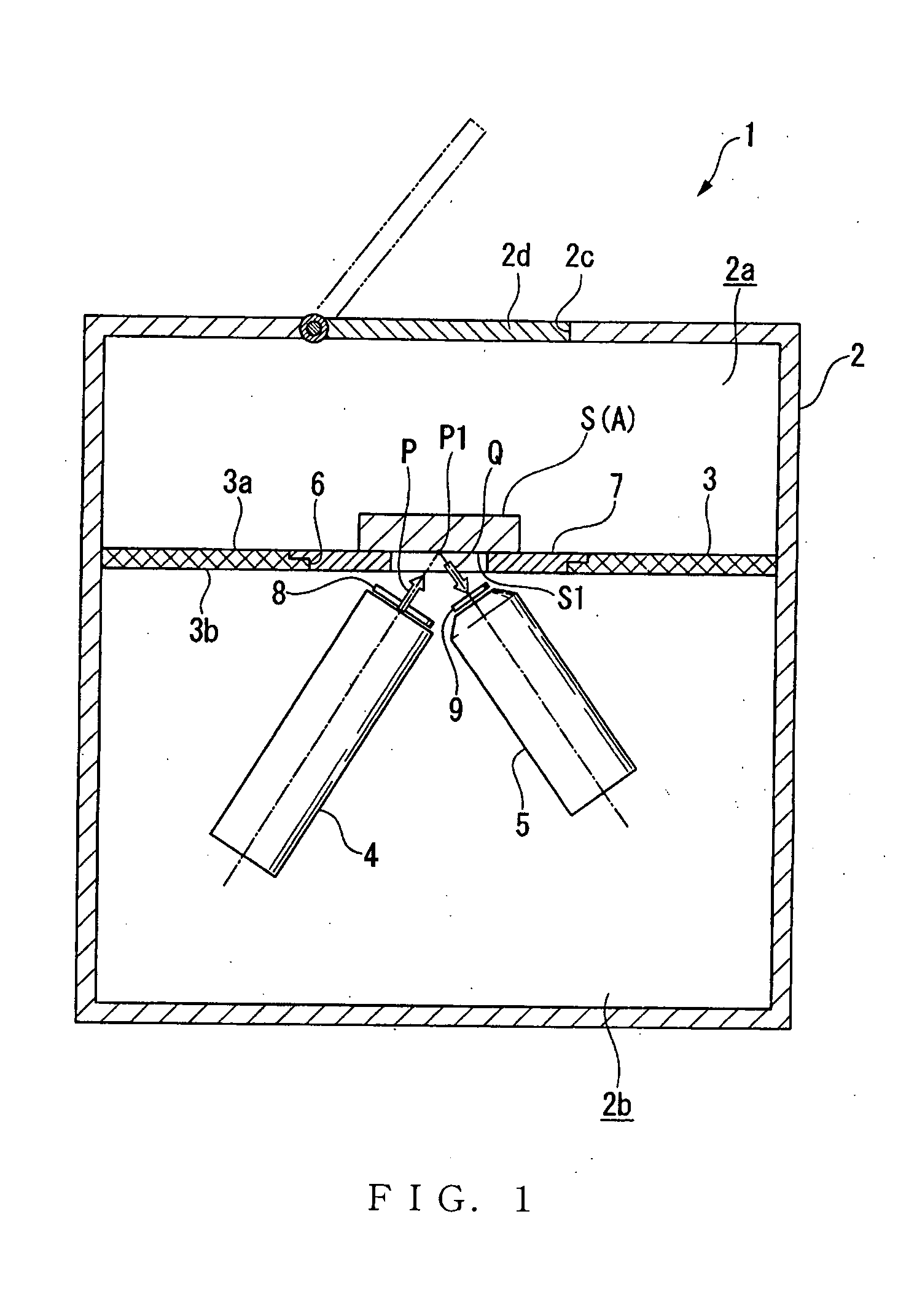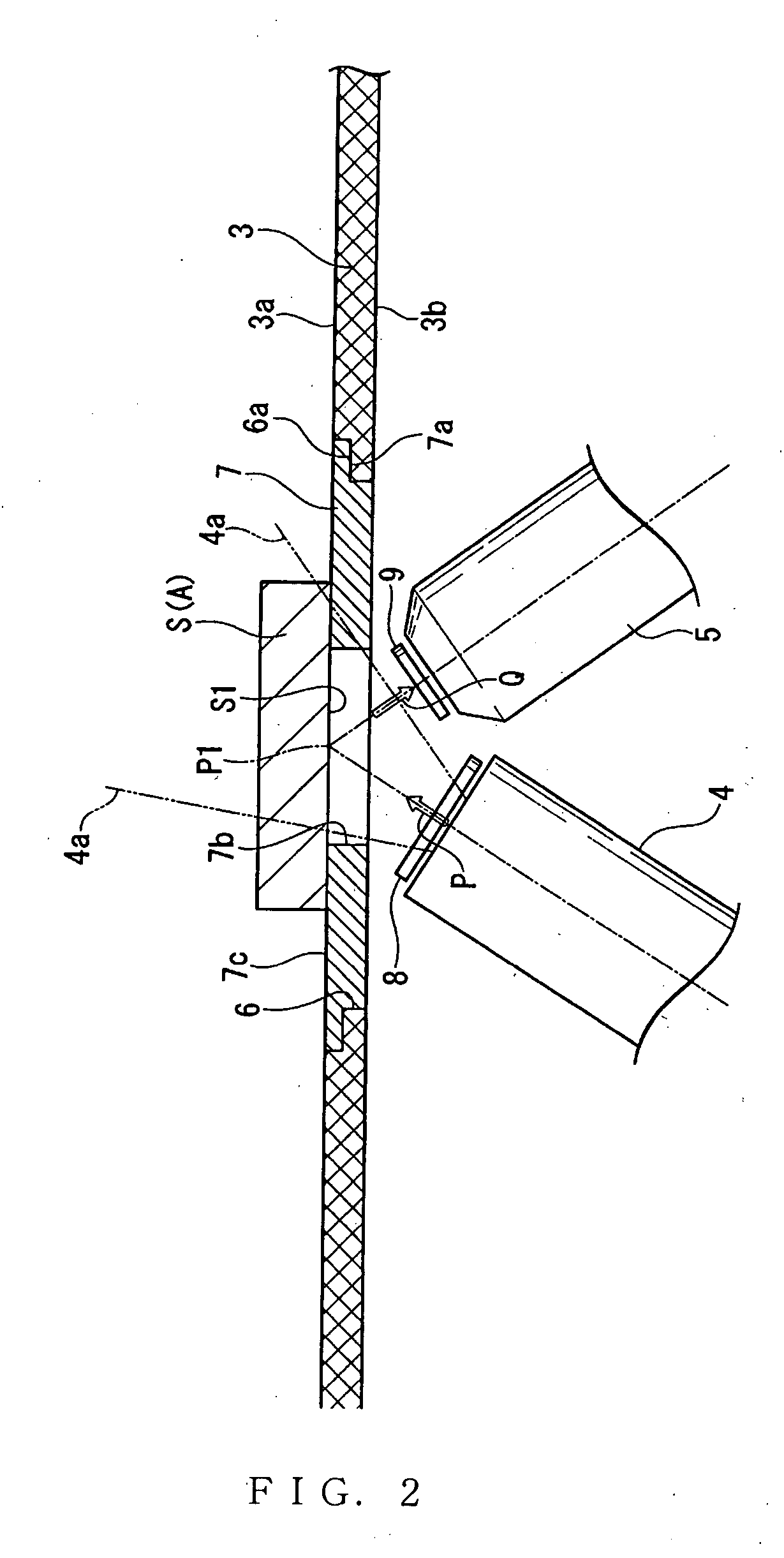[0012] According to the fluorescent X-ray analysis apparatus concerned with this invention, in a case where the sample is one whose main component is the
heavy element for instance, the sample is disposed to the 1st inspection position in the sample base. And, by irradiating the primary X-ray by the X-ray source to the irradiated face, of the sample, coinciding with the irradiation position, the sample is excited in an extreme surface range of the sample, in which the irradiation position has been made the center, and the fluorescent X-ray is generated. And, by the fact that the detector is disposed toward the irradiation position, the fluorescent X-ray having been generated is efficiently detected by the detector.
[0013] Further, in a case where the sample contains the light element for instance as its main component and the aimed element (element to be quantified) is contained in a trace, the sample is disposed to the 2nd inspection position by mounting the sample holding tool to the sample base and fixing the sample to the sample holding tool. In the 2nd inspection position, the sample is disposed with the irradiated face being approached to the X-ray source. Therefor, since the primary X-ray irradiated from the X-ray source is irradiated, without being attenuated, to the sample in a
high density and while having a large
solid angle, it is possible to raise an intensity of the primary X-ray irradiated. Further, in a case where the sample contains the light element as its main component, the primary X-ray is transmitted not only through the extreme surface range in which the irradiation position has been made the center like the above but also till an inside of the sample. And, in a range of the sample, to which the X-ray is irradiated and through which it transmits, the primary X-ray excites the aimed element contained in this range, thereby generating the fluorescent X-ray. The fluorescent X-ray having been generated additionally transmits through the inside of the sample, and is detected by the detector. On this occasion, since the detector is disposed while being approached to the inspected face of the sample, and the
solid angle to the sample generating the fluorescent X-ray is formed large, the fluorescent X-ray is efficiently entered, without being attenuated, to the detector in a
high density, and detected.
[0020] According to the fluorescent X-ray analysis apparatus concerned with this invention, the primary X-ray having been irradiated to the irradiated face, of the sample, having been disposed in the 2nd inspection position transmits through the inside of the sample, excites the aimed element contained in the sample, generates the fluorescent X-ray, and is irradiated to the secondary exciting wall butting against the face opposed to the irradiated face of the sample. The secondary exciting wall generates, by the fact that the primary X-ray is irradiated to it, the secondary excitation fluorescent X-ray whose energy is higher than the energy of the fluorescent X-ray that the aimed element contained in the sample generates. The secondary excitation fluorescent X-ray generated from the secondary exciting wall is irradiated to the sample, and the aimed element of the sample is excited also by the secondary excitation fluorescent X-ray, thereby generating the fluorescent X-ray. Therefor, it is possible to additionally raise an intensity of the fluorescent X-ray generated from the aimed element of the sample, i.e., an intensity of the fluorescent X-ray obtainable by the detector.
[0022] According to the fluorescent X-ray analysis apparatus concerned with this invention, also in a case where the sample is the
solid or the liquid, which has the fluidity, the sample has a regular shape by being encapsulated in the sample encapsulation container, and it is possible to form the irradiated face and the detected face of the sample. Therefor, similarly to the sample of the solid having a certain regular shape, it is possible to detect the fluorescent X-ray generated from the sample by being disposed in the 1st inspection position or the 2nd inspection position and irradiating the primary X-ray to the sample. Further, even in a case where the sample has been the solid having the regular shape, the sample can be easily made a shape suitable for a measurement by being made a granular form, a powdery form or a liquid by being dissolved, and encapsulated in the sample encapsulation container. Incidentally, since the sample encapsulation container is formed by the material through which the primary X-ray and the fluorescent X-ray can transmit, there is no fact that the primary X-ray and the fluorescent X-ray attenuate and the intensity of the fluorescent X-ray obtainable by the detector decreases.
[0024] According to the fluorescent X-ray analysis apparatus concerned with this invention, by the fact that the sample encapsulation container is formed in the trapezoidal shape in section, the sample encapsulated in the sample encapsulation container and having been fixed to the 2nd inspection position is disposed radiately with respect to the detector. Therefor, if an angle opening from an upper side to a lower side of the trapezoid that is the sectional shape of the sample encapsulation container is set to an angle equal to a detectable
solid angle of the detector, it is possible to efficiently detect the fluorescent X-ray generated from the whole sample having been encapsulated.
[0025] According to the fluorescent X-ray analysis apparatus of the present invention, by possessing the X-ray source irradiating the primary X-ray with the predetermined irradiation position being made the center and the detector having been disposed toward the irradiation position, in the case where the sample contains the
heavy element as its main component, it is possible to detect the fluorescent X-ray generated from the range in which the irradiation position is made the center by disposing the sample to the 1 st inspection position. Further, by mounting the sample holding tool to the sample base, it is possible to dispose the sample while being approached to the X-ray source and the detector with the sample being made the 2nd inspection position. Therefor, it is possible to raise the intensity, i.e., sensitivity, of the fluorescent X-ray obtainable by the detector to thereby improve the detection
lower limit, and it is possible to realize an accurate quantitative determination of the trace aimed element having been contained not only in the sample whose main component is the heavy element but also in the sample whose main component is the light element.
 Login to View More
Login to View More 


